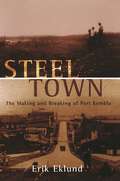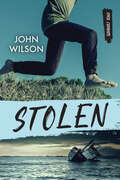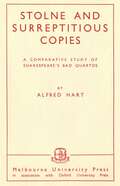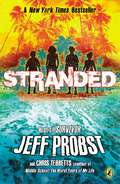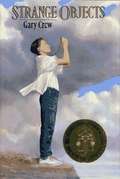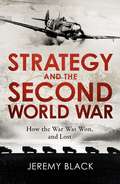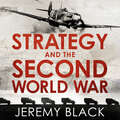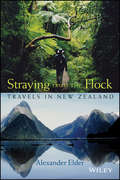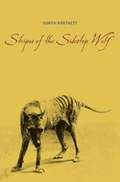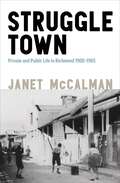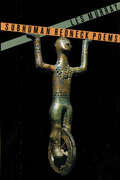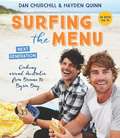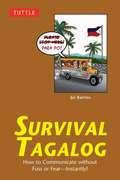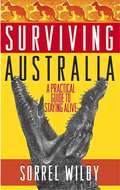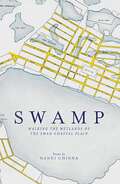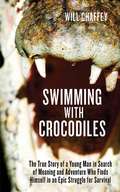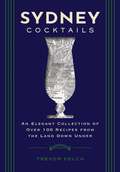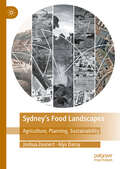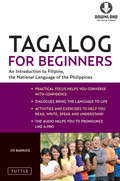- Table View
- List View
Steel Town: The Making and Breaking of Port Kembla
by Eklund, ErikThe sun moves across the narrow coastal plain that borders the range to the north . . . It shows once separate places now merged into one suburban entity, a ribbon of residential, commercial and industrial development . . . There is a commercial centre whose tall metallic and glass structures reflect the light, and celebrate an industrial heritage. And to the south, an area where a mass of industrial buildings converge around a large harbour. This area stands as a telling symbol of the region's golden industrial age. To most Australians Port Kembla is a grimy, polluted, industrial wasteland located down the coast from Sydney. Such images were formed over fifty years ago when industrial development in the town was at its height, and when the expanse of breathtaking coast had been colonised by the stacks and furnaces of heavy industry. Yet the vision of stacks and pollution from furnaces was never the whole story—there was always more to Port Kembla. Although these ideas persist even today, they obscure the real experiences of the people of the port. Steel Town illuminates our understanding of the processes of industrial and social change. Port Kembla was unique in Australian terms—an urban environment where industrial society shaped local life and politics like nowhere else. This book explores the advent and implications of industrial society—and the impact of economic decline and deindustrialisation. In his comprehensive and persuasive account of local life Erik Eklund draws together themes of migration, gender, class and identity. Using archival records, oral history interviews and company documents, Steel Town charts the relationship between economic change and the human experience of that change. The story of Port Kembla is the story of the 'big issues' of Australian history writ small on the lives of three generations of local people. The legacy of industrial society is a mixed one; its experiences and consequences are full of contradictions. And that, of course, is the beauty of history.
Still Here: Memoirs of Trauma, Illness and Loss (Routledge Interdisciplinary Perspectives on Literature)
by Fiona Giles Bunty Avieson Sue JosephStill Here: Memoirs of Trauma, Illness and Loss explores the history, ethics, and cross-cultural range of memoirs focusing on illness, death, loss, displacement, and other experiences of trauma. From Walt Whitman’s Civil War diaries to kitchen table survivor-to-survivor storytelling following Hurricane Katrina, from social media posts from a refugee detention centre, to poetry by exiles fleeing war zones, the collection investigates trauma memoir writing as healing, as documentation of suffering and disability, and as political activism. Editors Bunty Avieson, Fiona Giles and Sue Joseph have brought together this scholarly collection as a sequel to their earlier Mediating Memory (Routledge 2018), providing a closer look at the specific concerns of trauma memoir, including conflict and intergenerational trauma; the therapeutic potential and risks of trauma life writing; its ethical challenges; and trauma memoir giving voice to minority experiences.
Stolen (Orca Currents)
by John WilsonOn a visit to a seaside town in Australia, fifteen-year-old Sam meets Annabel, who works at the local museum. Annabel's interest in history is infectious, and Sam soon finds himself eager to hunt for the remains of a boat called the Mahogany Ship--a shipwreck sought after by many. When a storm creates an erosion hole that exposes a structure, Sam and Annabel are convinced it's the fabled ship. Soon all of the museum staff are at the erosion site to check it out. But the same storm also destroys the museum's power; someone knows the alarms aren't working and steals the museum's most treasured artifact, a large porcelain peacock worth $4 million. As Sam and Annabel search for the thief, they realize there may be a link between the fabled shipwreck and the recent theft.
Stolne and Surreptitious Copies: A Comparative Study of Shakespeare's Bad Quartos
by Alfred HartThis volume was the first book devoted entirely to an investigation of the many problems associated with the relation between the 'stolne and surreptitious copies' of which Heminge and Condell complain in their address 'To the great Variety of Readers,' and the corresponding plays of Shakespeare printed by them in the first folio. For nearly two and a half centuries prior to the publication of the important Cambridge Shakespeare of 1863-6, many editors and commentators held firmly to the opinion that these words condemned all the quarto editions published in the life-time of the poet. They preferred to rely on the folio version for the text of a play although careful collation had previously proved that the folio text of this play had been set up from one of the earlier quarto editions.
Stranded
by Jeff ProbstA New York Times Bestseller! As seen on The Today Show, Rachael Ray, and Kelly and Michael. From the Emmy-Award winning host of Survivor, Jeff Probst, with Middle School: The Worst Years of My Life co-author, Chris Tebbetts, comes a brand new family adventure series! A family vacation becomes a game of survival! It was supposed to be a vacation--and a chance to get to know each other better. But when a massive storm sets in without warning, four kids are shipwrecked alone on a rocky jungle island in the middle of the South Pacific. No adults. No instructions. Nobody to rely on but themselves. Can they make it home alive? A week ago, the biggest challenge Vanessa, Buzz, Carter, and Jane had was learning to live as a new blended family. Now the four siblings must find a way to work together if they're going to make it off the island. But first they've got to learn to survive one another.
Strange Objects
by Gary CrewAfter discovering valuable relics from a seventeenth-century shipwreck, a sixteen-year-old Australian disappears under mysterious circumstances.
Strategy and the Second World War: How the War was Won, and Lost
by Jeremy BlackA concise, accessible account of strategy and the Second World War. How the war was won . . . and lost..In 1941, the Second World War became global, when Nazi Germany attacked the Soviet Union; Japan attacked the United States at Pearl Harbor; and Germany declared war on the United States.In this timely book, which fills a real gap, Black engages with the strategic issues of the time - as they developed chronologically, and interacted - and relates these to subsequent debates about the choices made, revealing their continued political resonances.Beginning with Appeasement and the Soviet-German pact as key strategic means, Black examines the consequences of the fall of France for the strategies of all the powers. He shows how Allied strategy-making was more effective at the Anglo-American level than with the Soviet Union, not only for ideological and political reasons, but also because the Americans and British had a better grasp of the global dimension.He explores how German and Japanese strategies evolved as the war went badly for the Axis powers, and discusses the extent to which seeking to mould the post-war world informed Allied strategic choices from 1943 onwards, and the role these played in post-war politics, notably in the Cold War. Strategy was a crucial tool not only for conducting the war; it remains the key to understanding it today.
Strategy and the Second World War: How the War was Won, and Lost
by Jeremy BlackA concise, accessible account of strategy and the Second World War. How the war was won . . . and lost..In 1941, the Second World War became global, when Nazi Germany attacked the Soviet Union; Japan attacked the United States at Pearl Harbor; and Germany declared war on the United States.In this timely book, which fills a real gap, Black engages with the strategic issues of the time - as they developed chronologically, and interacted - and relates these to subsequent debates about the choices made, revealing their continued political resonances.Beginning with Appeasement and the Soviet-German pact as key strategic means, Black examines the consequences of the fall of France for the strategies of all the powers. He shows how Allied strategy-making was more effective at the Anglo-American level than with the Soviet Union, not only for ideological and political reasons, but also because the Americans and British had a better grasp of the global dimension.He explores how German and Japanese strategies evolved as the war went badly for the Axis powers, and discusses the extent to which seeking to mould the post-war world informed Allied strategic choices from 1943 onwards, and the role these played in post-war politics, notably in the Cold War. Strategy was a crucial tool not only for conducting the war; it remains the key to understanding it today.
Strategy and the Second World War: How the War was Won, and Lost
by Jeremy BlackA concise, accessible account of strategy and the Second World War. How the war was won . . . and lost..In 1941, the Second World War became global, when Nazi Germany attacked the Soviet Union; Japan attacked the United States at Pearl Harbor; and Germany declared war on the United States.In this timely book, which fills a real gap, Black engages with the strategic issues of the time - as they developed chronologically, and interacted - and relates these to subsequent debates about the choices made, revealing their continued political resonances.Beginning with Appeasement and the Soviet-German pact as key strategic means, Black examines the consequences of the fall of France for the strategies of all the powers. He shows how Allied strategy-making was more effective at the Anglo-American level than with the Soviet Union, not only for ideological and political reasons, but also because the Americans and British had a better grasp of the global dimension.He explores how German and Japanese strategies evolved as the war went badly for the Axis powers, and discusses the extent to which seeking to mould the post-war world informed Allied strategic choices from 1943 onwards, and the role these played in post-war politics, notably in the Cold War. Strategy was a crucial tool not only for conducting the war; it remains the key to understanding it today.
Straying from the Flock
by Alexander ElderAn illuminating road trip through the history, life, and attractions of one of the most beautiful countries in the southern hemisphere The beauty and grandeur of New Zealand has captured the imagination of movie-goers over the past couple of years, and the country is a dream destination for many around the world. Straying from the Flock is an intimate and personal account of one passionate traveler's visit to this incredible country, its mountains and beaches, fjords, rainforests, vineyards, and hidden eateries. Each of the fifty chapters describes one day in his travels-fishing, flying, cattle herding, befriending locals at every turn. Filled with colorful stories and memorable personalities, the book not only describes the trip of a lifetime, but captures a life-altering experience for its writer. From mountains and rainforests to cities and beaches, Straying from the Flock is both a moving memoir and personal travel guide to this amazing country.
Stretcher-bearers
by Mark JohnstonStretcher-bearers is a compelling account of the experience of Australian stretcher-bearers during the First and Second World Wars. Respected military historian, Mark Johnston traces the development of formal stretcher-bearing from its origin in the early nineteenth century under Napoleon to the Second World War. Johnston draws on accounts by stretcher-bearers who worked on the front line, as well as tributes from rescued soldiers, to deepen our understanding of the crucial role these soldiers played in Gallipoli, Palestine, the Western Front in World War I, and in the Middle East and the Pacific in World War II. The narrative is further driven by rich imagery, featuring over 130 full-page photographs. This book provides a generously illustrated, engaging and moving account of the history of the stretcher-bearer, a figure praised by countless Diggers but never previously the subject of a book.
Stripes of the Sidestep Wolf
by Sonya HartnettSatchel O'Rye, devoted son of an impoverished couple in a dying rural town, must weigh in balance the life of his most cherished dog and the freedom of a mysterious rare animal.
Struggletown: Public and Private Life in Richmond 1900–1965
by Janet McCalman'The old Struggletowners, if they could see it now, would not believe their eyes.' In Struggletown, Janet McCalman takes us into the inner-city industrial working-class suburb of Richmond, in Melbourne, before the gentrification of the 1970s. This is a narrative richly informed by the voices and memories of those who lived there during this time - the Struggletowners themselves - as well as by McCalman's familiarity with the objects, buildings and topography of their physical environment and her impressive awareness of larger social forces, structures and patterns. As urban life continues to develop in new directions and complex human and political relations suggest new futures, the difficulty and necessity of remembering, now, also lends this classic work a palpable new relevance.
Subhuman Redneck Poems
by Les MurrayIn this collection of poems, farmers, fathers, poverty-stricken pioneers, and people blackened by the grist of the sugar mills are exposed to the blazing midday sun of Murray's linguistic powers. Richly inventive, tenderly perceptive, and fiercely honest, these poems surprise and bare the human in all of us.
Surfing the Menu
by Dan Churchill Hayden QuinnEscape on an epic adventure around Australia with Dan Churchill and Hayden Quinn, as seen on ABC TV Discover the spectacular natural diversity of the north of Australia, from Broome to Byron, with two of Australia's favourite food lovers and cooks, and enjoy 80 amazing recipes inspired by local growers and food producers. Along with Gigi, an intrepid vintage VW Beetle, MasterChef stars Dan Churchill and Hayden Quinn travel from the west coast, to the north, and then to the east coast of Australia to explore what's cooking and the incredible produce of each spectacular region -- and being surfer dudes, to catch some waves too! In this full colour, 240-page cooking and travel extravaganza, cook with Dan and Hayden's inspiring recipes and enjoy the colour, life and tastes that the west, north and east of our great country has to offer. From Shark Bay thorugh to Wooramel, Carnarvon, Exmouth and Broome in Western Australia, to Kununurra and Katherine in the Northern Territory, to Cairns and Townsville, The Whitsundays and Bundaberg in Queensland, and finally Noosa Toowoomba and Bryon Bay in New South Wales, their journey is showcased with stunning photography of each lush location and the mouthwatering produce and recipes they discover and cook with along the way. In association with the ABC, the television series of Surfing the Menuwill be aired in early 2016. The first two series introduced us to Curtis Stone and Ben O'Donoghue, and now it's time to hit the surfing trail again with a new generation of food lovers and cooks - Dan Churchill and Hayden Quinn. Get cooking and share in the trip of a lifetime!
Survival Tagalog
by Joi BarriosA handy Tagalog phrasebook and guide to the official language of The Philippines, Survival Tagalog contains basic vocabulary necessary for getting around.This book contains all the necessary words and phrases for speaking Tagalog. In addition to being a Tagalog phrase book, it also contains a beginner guide to the Tagalog language, allowing for a deeper understanding of Tagalog than a typical Tagalog phrasebook or Tagalog dictionary. The book is broken into five basic sections: Common Tagalog Expressions and Key Words, Numbers and Counting in Tagalog, Tagalog Travel Vocabulary and Useful Tagalog Expressions, Filipino Geography Guide and Readings Signs in Tagalog, and Additional Tagalog Vocabulary Pronunciation Guides for Key Filipino Names and Signs. All Tagalog words and phrases are written in Tagalog as well phonetically, making pronouncing Tagalog a breeze.This phrasebook includes:Hundreds of useful Tagalog words and expressionsAn A-Z index with more than 1,000 additional words and their pronunciation, allowing the book to be used as an English to Tagalog dictionaryRomanized forms and phonetic spellings for all words and phrasesA concise background and history of the Tagalog People, Tagalog language and The PhilippinesAn introduction to the Tagalog and Filipino AlphabetsA pronunciation guide for speaking TagologA guide to Tagalog grammar
Survival Tagalog
by Joi BarriosA handy Tagalog phrasebook and guide to the official language of The Philippines, Survival Tagalog contains basic vocabulary necessary for getting around.This book contains all the necessary words and phrases for speaking Tagalog. In addition to being a Tagalog phrase book, it also contains a beginner guide to the Tagalog language, allowing for a deeper understanding of Tagalog than a typical Tagalog phrasebook or Tagalog dictionary. The book is broken into five basic sections: Common Tagalog Expressions and Key Words, Numbers and Counting in Tagalog, Tagalog Travel Vocabulary and Useful Tagalog Expressions, Filipino Geography Guide and Readings Signs in Tagalog, and Additional Tagalog Vocabulary Pronunciation Guides for Key Filipino Names and Signs. All Tagalog words and phrases are written in Tagalog as well phonetically, making pronouncing Tagalog a breeze.This phrasebook includes:Hundreds of useful Tagalog words and expressionsAn A-Z index with more than 1,000 additional words and their pronunciation, allowing the book to be used as an English to Tagalog dictionaryRomanized forms and phonetic spellings for all words and phrasesA concise background and history of the Tagalog People, Tagalog language and The PhilippinesAn introduction to the Tagalog and Filipino AlphabetsA pronunciation guide for speaking TagologA guide to Tagalog grammar
Surviving Australia: A Practical Guide to Staying Alive
by Sorrel WilbyVisiting the Australian outback can be a wonderful experience, but it isn't all about boomerangs and koalas, kangaroos and didgeridoos. It can be a wild and dangerous place if you're not prepared. Here is the essential travel companion for enduring the toughest stuff this rugged continent can offer -- a veritable survivor's guide to managing the unexpected when you're Down Under. Renowned Australian adventurer and bestselling author Sorrel Wilby provides you with the basic lessons on negotiating your way through the bush, across the outback, over the top end, and into the surf and sea. You'll get important lifesaving information on: where you should and shouldn't be driving your Range Rover dealing with natural hazards like river crossings, bush fires, storms, and rips warding off snakes, scorpions, crocs, and sharks encountering Aboriginal people, Bushies, Eccentrics, and Surfers finding food and water treating heatstroke, hypothermia, and tropical infections identifying proper emergency radio frequencies and much more!
Sustainable Family Farming and Yeoman Ideals: 1860 to 2000 in North-West Tasmania
by Rena R. HendersonWithin the frame of family farming, this book offers a longitudinal study of the Castra district in North-West Tasmania from first European settlement to the end of the twentieth century. It draws upon historical sources for yeomanry characteristics from Britain, Canada, the USA, New Zealand and Australian mainland colonies to show how these characteristics were persistently supportive of family farming. Surveying farming communities over several generations, this book explores a range of topics including colonial surveying practices, settler families’ motivation, attributes and demographics, the role of Methodism, the ways children were inculcated into yeoman farming enterprises, the role of women as companionate wives, and the political participation of farmers in the public sphere. The book also offers a new perspective of three commonly-held myths of settlement failure: the settlement of retired Anglo-Indian military and civil officers in the 1870s, the settlement of soldiers on small farms after the Great War, and the claims that the ideal of yeoman family farming was anachronistic to capitalist commodity production. The book draws from a wide selection of previously underused primary source materials, including oral histories from current and past residents, to provide a comprehensive overview of an important aspect of rural Australian history.The book is a valuable contribution to Australian historiography, and will be a useful resource for students and scholars of rural history, social history, environmental history, colonialism and sustainable agriculture.
Sustaining Prosperity
by Peter Dawkins Michael StutchburyWhere are the new reform opportunities to ensure economic expansion? How should we face the challenges of an ageing population? How will we spread prosperity to the areas of entrenched disadvantage? These questions were the focus of the Sustaining Prosperity conference, hosted by the Melbourne Institute of Applied Economic and Social Research and The Australian in March-April 2005 at the University of Melbourne. A unique gathering of government ministers, opposition spokespeople, academic experts and business, social welfare and trade union figures debated a new national reform agenda to sustain prosperity. Participants included Federal Treasurer Peter Costello, federal Opposition Leader Kim Beazley, federal Treasury Secretary Ken Henry, economist Ross Garnaut, ACTU secretary Greg Combet and Australian Council of Social Service president Andrew McCallum. In Sustaining Prosperity, Peter Dawkins and Michael Stutchbury bring together the contributions of these and other leading Australians to examine the development of policies that will ensure a prosperous future for Australia.
Swamp: Walking the Wetlands of the Swan Coastal Plain
by Nandi ChinnaFor the last four years Nandi Chinna has walked the wetlands of the Swan Coastal Plain—and the paths and streets where the wetlands once were—uncovering the lost places that exist beneath the townscape of Perth. She writes with poignancy and beauty of our inability to return, and the ways in which we can use the dual practice of writing and walking to reclaim what we have lost. Her poems speak with urgency about wetlands that are under threat from development today.
Swimming with Crocodiles: The True Story of a Young Man in Search of Meaning and Adventure Who Finds Himself in an Epic Struggle for Survival
by Will ChaffeyIn the tradition of Into the Wild, here is the riveting story of a young man seeking his own truth and finding adventure in the awesome, unforgiving power of nature. Will Chaffey is eighteen when he boards a plane in New York bound for Australia. Taking time off to work and travel, Will meets an enigmatic wanderer and herpetologist. Together they cross the inland desert to the tropical northwest coast, home to the saltwater crocodile, a known man- eater and a predator who has been hunting since the age of the dinosaurs. They devise a plan to explore the remote Prince Regent River, a trek so dangerous it had never been attempted by outsiders. Passing through harsh, primeval country, shadowed by their own exhaustion, and physically worn down, they find themselves locked in a life-and-death struggle when their food runs out and, unable to leave, they are stalked by a hungry crocodile. Filled with scenes of great natural beauty, Swimming with Crocodiles is at once the affecting account of a journey into adulthood and a hair- raising epic of survival.
Sydney Cocktails: An Elegant Collection of Over 100 Recipes Inspired by the Land Down Under
by Trevor FelchSydney Cocktails is an elegant collection of over 100 recipes inspired by the land down under.These signature drink recipes from Sydney hotspots pay homage to the flavor capital of Australia. With over 100 recipes and dozens of bartender profiles, you can drink like a local whether you&’re just visiting or entertaining at home. From Polynesian tiki bars to 70s-inspired retro lounges,locals and tourists alike will discover new watering holes that are sure to satisfy all tastes. With the best signature creations by prominent mixologists in the area, this book offers a detailed rundown of the best locations Sydney has to offer.Within the gorgeous, die-cut covers, you'll find: More than 100 essential and exciting cocktail recipes, including recipes for bespoke ingredients and other serving suggestionsInterviews with the city&’s trendsetting bartenders and mixologistsBartending tips and techniques from the experts - Food and drink hotspots across the cityAnd much more!Golden beaches, aqua seas, glamorous nightlife--nowhere does it quite like Sydney. Enjoy this multicultural craft cocktail scene without ever leaving your zip code with Sydney Cocktails.
Sydney’s Food Landscapes: Agriculture, Planning, Sustainability
by Joshua Zeunert Alys DaroyThe story of Sydney’s metropolitan food landscapes is one of dramatic transformations of First Nations land amidst jostles for power and wealth. This book unearths Sydney's lost commercial agriculture since colonisation in 1788 to assess its fragile food futures. Richly illustrated, 270 images are encapsulated within 110 figures, including an array of original metropolitan-scale mappings. Discussion traverses the city’s diverse cultural influences, from Indigenous land management to British pastoralism, Chinese cultivation of Sydney’s “backyard vegetable garden” and southern European farming spawning billion-dollar empires. The region has further been shaped by a vast array of cultural and ideological factors and material practices, with relevance to planning, policy, ethics, geography, heritage, art, design and technology. This book is the first to bring Sydney’s disparate post-colonial food histories together in one volume to explore the dynamics and tensions between urban growth and food production. The relevance of Sydney’s food landscapes therefore extends far wider than the city itself, with implications for countless regions worldwide in a time of increasing climate and resource precarity.
Tagalog for Beginners
by Joi BarriosThis is a straight-forward and user-friendly guide to the Tagalog language. Tagalog for Beginners is the book to help you learn Tagalog (Filipino) on your own, easily and accurately-whether you're traveling to the Philippines for a vacation or a business trip, or you have ties to the large Tagalog-speaking community in the U. S. , or you're simply a language lover. From the fascinating history of Philippines' language to how you speak it, join skilled teacher Barrios on a guided introduction-with a practical focus. After journeying through the carefully-paced explanations, conversations, cultural info, and activities in Tagalog for Beginners, learners will be able to use Tagalog (Filipino) in a wide range of common situations. From shopping for food to asking directions, from telling time to expressing how you feel, this book gives you the communication skills you need. The MP3 audio-CD helps reinforce pronunciation and improve listening comprehension. Helpful suggestions guide heritage learners (those of Filipino descent but born outside the Philippines) on how to use the book most effectively for their needs. Key features include:: An accompanying MP3 Audio CD. Realistic dialogues to bring the language to life. Activities and exercises to help you read, write, speak and understand. Notes on the Tagalog language and history. A special section guides native (heritage) learners and instructors on how to use the book most effectively for their needs.
